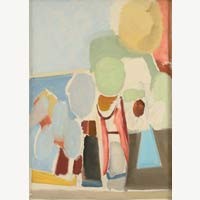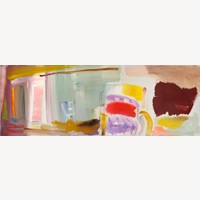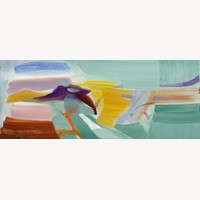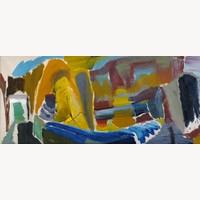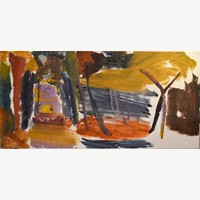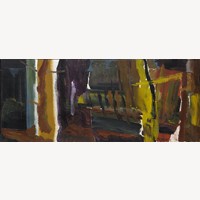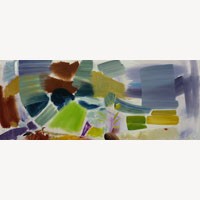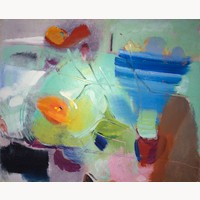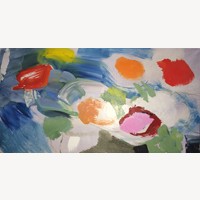Ivon Hitchens (1893–1979)
Ivon Hitchens Biography
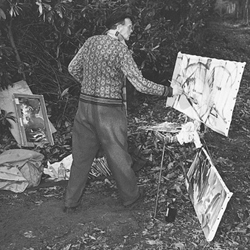
Ivon Hitchens’ Coronation of 1937 is one of the Tate’s hidden treasures, a painting that is both of its era and also ahead of its time. On the one hand, it is the apotheosis of the Modern Movement in Britain in the Thirties, in its synthesis of the avant-garde theories coming out of Paris, Amsterdam and Berlin that were so influential on his contemporaries, such as Nicholson, Hepworth and Moore. On the other, the freedom with which Hitchens handles the division of the pictorial space through loose, irregular blocks of expressively brushed colour, has almost as much in common with abstract painting of some twenty years later. It is as if he saw in the work of those European masters who passed through London in the Thirties exactly the same possibilities as a younger generation of American painters would, after their arrival in New York, at the onset of the War.
This painting, however, just as it represents a high-water mark of early modernism in this country, also signals an end – or a departure point – for Ivon Hitchens himself. By the following year, he was fully immersed in the project that was to occupy him for the rest of his career: translating the world around him (or, more precisely, his experience of the world around him) into a coherent painterly language, that both described a sense of place, of movement, of the ‘in and out’ spaces between things, but which was also inseparable from its own formal logic, of harmony between colour and tone, weight of paint and energy of the brush-mark, in counterpoint to the physical parameters of the canvas itself.
The house and studios that Ivon Hitchens built over the years deep in the Sussex countryside have, in time, become a metaphor for his isolation from the London art world. Yet his decision to paint the physical world was itself a radical, almost subversive choice, for someone in his artistic milieu, and it gave him an unparalleled freedom to pursue his vision. For Ivon Hitchens, the woods that surrounded him, the shallow ponds he dug to reflect the pattern of trees and sky, the conservatory of flowers with its ever-changing mosaics of colour – all had the same function as the pristine environment that Mondrian insisted upon wherever he lived: they were the essential, basic conditions within which art could be made.
Twentieth-century British art is often damned with faint praise when compared to its European and American counterparts, with our response to key ideas and ideologies seen as symptomatic of a post-colonial cultural inferiority complex. This attitude is very much in evidence in the critical reaction to this year’s ‘Picasso and Modern British Art’ exhibition at Tate Britain, yet it is ironic that all that the critics of this show lament as lacking in Ivon Hitchens’ more fêted contemporaries – certainty, lack of compromise – is very much present in the work of an artist rarely mentioned in the same sentence as ‘modernism’. Patrick Heron, in his essay for the Penguin Modern Masters volume on Ivon Hitchens in 1955, certainly had no hesitation in viewing his work through the same formalist prism that Clement Greenberg was using at the time to define the primacy of Abstract Expressionism. Indeed, his text reads as a rehearsal for his own his break-through into pure abstraction, with his horizontal and vertical ‘stroke paintings’ of 1957. These works have since become symbolic of British art’s engagement with America, but, as Mel Gooding recently suggested to me, when discussing his essay for this catalogue, they owe more to Heron’s encounter with Ivon Hitchens than to anything happening across the Atlantic.
It doesn’t seem at all far-fetched, either, to speculate on how influential Ivon Hitchens’ work from the Forties onwards must have been on Howard Hodgkin’s paintings of the Eighties and Nineties. If Coronation can be seen to have been twenty years ahead of its time, then the works in this exhibition can be said to be to stretch even further, to the paintings that won the second Turner Prize.
1928 Arthur Tooth & Sons, London
1929 London Artists' Association, Cooling Galleries, London
1930 Heal's Mansard Gallery, London
1933 Alex Reid & Lefevre, London (also 1935 and 1937)
1934 Participated in Objective Abstractions, Zwemmer Gallery
1940 First of ten one-man exhibitions, Leicester Galleries (also in 1942, 1944, 1947, 1949, 1950, 1952, 1954, 1957 and 1959)
1945 Retrospective exhibition, Temple Newsam House, Leeds
1948 Retrospective exhibition, Graves Art Gallery, Sheffield
1953 Metropolitan Art Gallery, Tokyo
1956 Gimpel Fils, London
1956 Represented Britain at the XXVIII venice Biennale
1958 Laing Art Galleries, Toronto
1960 One man exhibition, Waddington Galleries, London (also in 1962, 1964, 1966, 1968, 1969, 1971, 1973, 1976, 1982, 1985, 1990, 1993 and 1996)
1963 Major retrospective exhibition arranged by the Arts Council, Tate Gallery, London
1964 Civic Art Gallery, Southampton, University of Southampton Arts Festival
1966 Tib Lane Gallery, Manchester, Poindexter Gallery, New York; Worthing Art Gallery
1967 Stone Gallery, Newcastle
1971 Basil Jacobs Fine Art, London
1972 Rutland Gallery, London, Landscape into Abstract
1978 Burstow Gallery, Brighton College
1978 Retrospective exhibition, Towner Art Gallery, Eastbourne
1979 Retrospective exhibition, Royal Academy
1980 Bohun Gallery, Henley-on-Thames
1982 New Art Centre, London
1987 Oriel 31, Welshpool and Newtown, Powys
1989 Retrospective exhibition, Serpentine Gallery, London
1991 Cleveland Bridge Gallery, Bath
1993 Bernard Jacobson Gallery, London
1993 Pallant House Gallery, Chichester
1993 Abbot Hall Art Gallery, Kendal
2000 Jonathan Clark Fine Art, London, A Visual Sound
2003 Jonathan Clark Fine Art, London, Landscapes
2005 Towner Art Gallery, Eastbourne
2005 Jonathan Clark Fine Art, Nudes
2007 Pallant House Gallery, Chichester
2007 Jonathan Clark Fine Art, London, The Flower Paintings
2009 Jonathan Clark Fine Art, London, Unseen Paintings from the 1930s
This painting, however, just as it represents a high-water mark of early modernism in this country, also signals an end – or a departure point – for Ivon Hitchens himself. By the following year, he was fully immersed in the project that was to occupy him for the rest of his career: translating the world around him (or, more precisely, his experience of the world around him) into a coherent painterly language, that both described a sense of place, of movement, of the ‘in and out’ spaces between things, but which was also inseparable from its own formal logic, of harmony between colour and tone, weight of paint and energy of the brush-mark, in counterpoint to the physical parameters of the canvas itself.
The house and studios that Ivon Hitchens built over the years deep in the Sussex countryside have, in time, become a metaphor for his isolation from the London art world. Yet his decision to paint the physical world was itself a radical, almost subversive choice, for someone in his artistic milieu, and it gave him an unparalleled freedom to pursue his vision. For Ivon Hitchens, the woods that surrounded him, the shallow ponds he dug to reflect the pattern of trees and sky, the conservatory of flowers with its ever-changing mosaics of colour – all had the same function as the pristine environment that Mondrian insisted upon wherever he lived: they were the essential, basic conditions within which art could be made.
Twentieth-century British art is often damned with faint praise when compared to its European and American counterparts, with our response to key ideas and ideologies seen as symptomatic of a post-colonial cultural inferiority complex. This attitude is very much in evidence in the critical reaction to this year’s ‘Picasso and Modern British Art’ exhibition at Tate Britain, yet it is ironic that all that the critics of this show lament as lacking in Ivon Hitchens’ more fêted contemporaries – certainty, lack of compromise – is very much present in the work of an artist rarely mentioned in the same sentence as ‘modernism’. Patrick Heron, in his essay for the Penguin Modern Masters volume on Ivon Hitchens in 1955, certainly had no hesitation in viewing his work through the same formalist prism that Clement Greenberg was using at the time to define the primacy of Abstract Expressionism. Indeed, his text reads as a rehearsal for his own his break-through into pure abstraction, with his horizontal and vertical ‘stroke paintings’ of 1957. These works have since become symbolic of British art’s engagement with America, but, as Mel Gooding recently suggested to me, when discussing his essay for this catalogue, they owe more to Heron’s encounter with Ivon Hitchens than to anything happening across the Atlantic.
It doesn’t seem at all far-fetched, either, to speculate on how influential Ivon Hitchens’ work from the Forties onwards must have been on Howard Hodgkin’s paintings of the Eighties and Nineties. If Coronation can be seen to have been twenty years ahead of its time, then the works in this exhibition can be said to be to stretch even further, to the paintings that won the second Turner Prize.
Exhibitions
1925 One-man exhibition, Mayor Gallery, London1928 Arthur Tooth & Sons, London
1929 London Artists' Association, Cooling Galleries, London
1930 Heal's Mansard Gallery, London
1933 Alex Reid & Lefevre, London (also 1935 and 1937)
1934 Participated in Objective Abstractions, Zwemmer Gallery
1940 First of ten one-man exhibitions, Leicester Galleries (also in 1942, 1944, 1947, 1949, 1950, 1952, 1954, 1957 and 1959)
1945 Retrospective exhibition, Temple Newsam House, Leeds
1948 Retrospective exhibition, Graves Art Gallery, Sheffield
1953 Metropolitan Art Gallery, Tokyo
1956 Gimpel Fils, London
1956 Represented Britain at the XXVIII venice Biennale
1958 Laing Art Galleries, Toronto
1960 One man exhibition, Waddington Galleries, London (also in 1962, 1964, 1966, 1968, 1969, 1971, 1973, 1976, 1982, 1985, 1990, 1993 and 1996)
1963 Major retrospective exhibition arranged by the Arts Council, Tate Gallery, London
1964 Civic Art Gallery, Southampton, University of Southampton Arts Festival
1966 Tib Lane Gallery, Manchester, Poindexter Gallery, New York; Worthing Art Gallery
1967 Stone Gallery, Newcastle
1971 Basil Jacobs Fine Art, London
1972 Rutland Gallery, London, Landscape into Abstract
1978 Burstow Gallery, Brighton College
1978 Retrospective exhibition, Towner Art Gallery, Eastbourne
1979 Retrospective exhibition, Royal Academy
1980 Bohun Gallery, Henley-on-Thames
1982 New Art Centre, London
1987 Oriel 31, Welshpool and Newtown, Powys
1989 Retrospective exhibition, Serpentine Gallery, London
1991 Cleveland Bridge Gallery, Bath
1993 Bernard Jacobson Gallery, London
1993 Pallant House Gallery, Chichester
1993 Abbot Hall Art Gallery, Kendal
2000 Jonathan Clark Fine Art, London, A Visual Sound
2003 Jonathan Clark Fine Art, London, Landscapes
2005 Towner Art Gallery, Eastbourne
2005 Jonathan Clark Fine Art, Nudes
2007 Pallant House Gallery, Chichester
2007 Jonathan Clark Fine Art, London, The Flower Paintings
2009 Jonathan Clark Fine Art, London, Unseen Paintings from the 1930s

